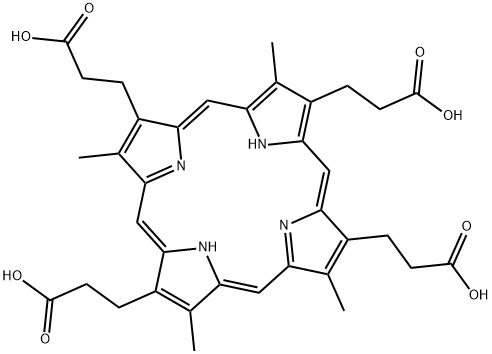14643-66-4
 14643-66-4 結(jié)構(gòu)式
14643-66-4 結(jié)構(gòu)式
基本信息
酚卟啉二鹽酸鹽
糞卟啉III二鹽酸鹽
Coproporphyrin dihydrochloride
Coproporphyrin Ⅲ dihydrochloride
CoproporphyrinIII Dihyrochloride
COPROPORPHYRIN III DIHYDROCHLORIDE
3,8,13,17-tetramethylporphyrin-2,7,12,18-tetrapropanoic acid
2,7,12,18-Tetramethyl-21H,23H-porphyrin-3,8,13,17-tetrapropionic acid
21H,23H-Porphine-2,7,12,18-tetrapropanoic acid, 3,8,13,17-tetramethyl-
3,8,13,17-TETRAMETHYL-21H,23H-PORPHINE-2,7,12, 18-TETRAPROPIONIC ACID DIHYDROCHLORIDE
物理化學(xué)性質(zhì)
常見問題列表
|
Human Endogenous Metabolite
|
Coproporphyrin III methyl ester is repeatedly isolated in considerable amount from both feces and urine. A great increase of coproporphyrin III excretion is unaccompanied by symptoms or signs of porphyria, metal or chemical poisoning or liver disease. Primary cultures of chick embryo hepatocytes have been used to study the mechanism by which chemicals cause accumulation of intermediates of the heme synthetic pathway. In the presence of the porphyrin precursor, 5-aminolevulinate (ALA), addition of insulin causes a striking increase in accumulation of uroporphyrin I and coproporphyrin III. Antioxidants abolishes the uroporphyrin I accumulation and increases coproporphyrin III.
Urinary DMA and porphyrin profile can be used as an early warning biomarker for chronic MMA exposure before the onset of cancer. After 4 weeks the level of coproporphyrin III concentration significantly increases in all the treatment groups compared to the control.
